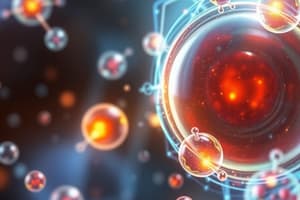Podcast
Questions and Answers
How do atoms and molecules differ from each other?
How do atoms and molecules differ from each other?
Atoms are the basic units of elements and can exist independently, while molecules are made of two or more atoms chemically bonded together.
Explain the difference between an element and a compound.
Explain the difference between an element and a compound.
An element is a pure substance made of only one type of atom, while a compound is a substance made of two or more different types of atoms chemically bonded together.
Give an example of an element that can exist both as a single atom and as a molecule.
Give an example of an element that can exist both as a single atom and as a molecule.
Hydrogen
How are compounds formed?
How are compounds formed?
Explain why the properties of compounds are different from the properties of their constituent elements.
Explain why the properties of compounds are different from the properties of their constituent elements.
What are the three main types of particles that make up an atom?
What are the three main types of particles that make up an atom?
How are molecules formed?
How are molecules formed?
What determines the chemical behavior of an atom?
What determines the chemical behavior of an atom?
What is the simplest molecule?
What is the simplest molecule?
Can elements be further broken down into simpler substances?
Can elements be further broken down into simpler substances?
Flashcards
Atom
Atom
The smallest unit of an element, composed of protons, neutrons, and electrons.
Molecule
Molecule
Two or more atoms bonded together.
Element
Element
Pure substance made of only one type of atom.
Compound
Compound
Signup and view all the flashcards
Covalent Bond
Covalent Bond
Signup and view all the flashcards
Proton
Proton
Signup and view all the flashcards
Neutron
Neutron
Signup and view all the flashcards
Electron
Electron
Signup and view all the flashcards
Periodic Table
Periodic Table
Signup and view all the flashcards
Fixed Ratio
Fixed Ratio
Signup and view all the flashcards
Study Notes
Structure of Matter: Atoms, Molecules, Elements, Compounds
Understanding how matter is structured can help us understand everything around us from solid objects to gases filling our atmosphere. This guide will explore the fundamental building blocks of matter - atoms, molecules, elements, and compounds, and their role in creating the world we live in.
Atoms
Atoms are indivisible units of matter representing the smallest possible portion of any chemical element. They are composed of three main types of particles: protons, neutrons, and electrons. Protons and neutrons reside within the nucleus, while electrons orbit the nucleus in shells or energy levels. The number of electrons determines the chemical behavior of an atom and its position in the periodic table. For example, all carbon atoms have six electrons and thus sit in group VI of period II in the periodic table.
Molecules
Molecules are formed when two or more atoms bond together through covalent bonds. These bonds form when atoms share electrons. Covalent bonds are formed when the electrons are shared equally between the atoms. The simplest molecule is hydrogen, which consists of two hydrogen atoms bonded together. Molecules can also have more complex structures. For example, water is a molecule made up of two hydrogen atoms bonded to one oxygen atom.
Elements
Elements are the basic building blocks of matter and cannot be further broken down into simpler substances. There are 118 known elements, which are arranged in the periodic table based on their atomic structure. Elements can exist as single atoms or as molecules. For example, hydrogen is an element and can exist both as a single atom and as a molecule, while oxygen is an element that can form molecules with other elements.
Compounds
Compounds are formed when two or more elements combine chemically. They can be formed through chemical reactions, such as combining hydrogen and oxygen to form water. In compounds, the atoms of the elements are bonded together in a fixed ratio. The properties of compounds are generally different from the properties of their constituent elements. For example, sodium and chlorine are elements, but when they combine to form sodium chloride (table salt), they form a compound with different properties than their individual elements.
Understanding the structure of matter, from atoms to compounds, is crucial for understanding the physical world around us. It helps us understand the properties of materials, the behavior of substances, and the principles behind chemical reactions. By exploring these fundamental building blocks of matter, we can gain a deeper appreciation for the complex systems that make up our universe.
Studying That Suits You
Use AI to generate personalized quizzes and flashcards to suit your learning preferences.




